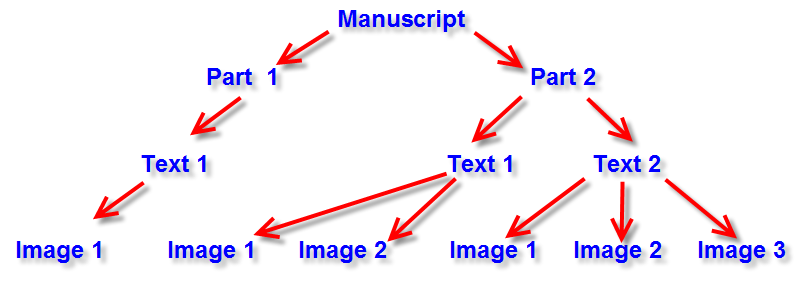2.3 Skeleton of the Database
The four main levels of the database —Manuscript, Part, Text, Image— are the skeleton that holds the entire construct upright; you'll notice them invoked in the inputting, in the revising, in the output (in whatever format: printed report for the single description; entire body of material or the various parts into Excel, Access, XML). Because of their foundational importance, you'll encounter them over and over again. A schematic rendering of the levels looks like this:

As you can see here, the simplest relationship among the segments of a description of a manuscript is represented by the single line on the left, and in the case of medieval manuscripts it occurs most blatantly with fragments, but it could of course be the situation with a codex as well: one manuscript, which is to say, one call number (i.e. Manuscript level) was produced physically in one place and at one time (Part level), and it contains one text, or piece of one text (Text level), and the library may choose only one photograph to represent this manuscript (Image level).
More common for medieval manuscripts is a complex relationship among the segments: pastedowns and flyleaves are often membra disiecta from another codex; many texts are bound together; an abundance of images gives the DS user a sense of the book overall with its many scribes and different illustrations. The reality of this spreading relationship is abstracted into the database via the complete schema of the diagram: one manuscript, two parts, of which the second has two texts (of which the first has two images, while the second text of Part 2 has three images); and all of this is bound with Part 1 (the lines on the left).
But, whether the codex's segments relate to one another in a simple or in a complex manner, the four levels will structure all activity: Manuscript, Part, Text, Image. Bear them well in mind; they'll come up over and over again.
